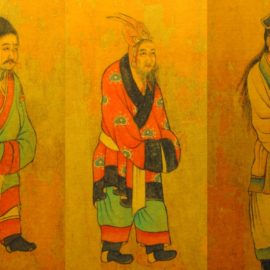

This article is an excerpt from the Shortform book guide to "Caste" by Isabel Wilkerson. Shortform has the world's best summaries and analyses of books you should be reading.
Like this article? Sign up for a free trial here .
What is a caste system? What are some real-world caste system examples?
Caste is a man-made social order developed to rank the value of certain groups of people. Some of the most pronounced caste system examples are India, Nazi Germany, and the United States of America.
Keep reading for real-world caste system examples and how they compare to each other.
Caste System Examples on the World Stage
A Caste system is a form of social stratification developed to separate groups of people and justify different treatment and living standards. There are many caste system examples on the world stage, but the most prominent ones include India, Nazi Germany, and the United States of America.
No one is likely to mistake the United States for India or see any parallelisms between Americans and Nazis anytime soon. But similarities exist between the United States and both societies, in that, all three had government-sanctioned caste systems. A review of the following caste system examples will help highlight the significant overlap between them.
India and USA Caste Systems
There is a strong historical connection between India and the United States. Both countries were invaded and conquered by British colonialists. The invaders exiled indigenous people of each country from their homeland and created hierarchies to distribute power to those asserting themselves as the dominant caste.
In both countries, that dominant caste persecuted the lowest caste. Both countries developed laws to maintain this social order and tortured the lower caste members who broke them. After centuries, both countries abolished the lawful caste systems, yet in both cases, the legacy of those social orders persists in the modern era.
Despite efforts in both countries to make amends to the subordinate caste by providing opportunities for growth, such as affirmative action in America or reservations in India, the dominant castes resent these new systems. Americans call it reverse racism, and Indians call it reverse casteism.
The difference is in the structures of the castes. Contrary to the bipolar caste system in the United States, India’s caste system was an intricate system of many castes and subcastes. The five main castes included the 1) Brahmin, 2) Kshatriya, 3) Vaishya, 4) Shudra, and 5) the Dalits. The Dalits were most commonly referred to as “Untouchables.”
Members of the different castes were most easily identified by their surnames. At the outset of this caste system, the Untouchables were given names with low connotations, such as those representing debased forms of labor. The Brahmins were given names taken from the gods. Caste members could also be identified by attire, accents, and demeanor.
Most people in India felt the caste system was beyond reproach because they believed the castes were preordained by reincarnation. Your lot in life was determined by the karma you accumulated in your past life. But the Untouchables, like the American slaves, didn’t feel the same about their position. They also wanted to live free from the confines of lawful oppression.
For example, many Dalits resisted their status and felt a kinship with blacks in America. In fact, a group of Dalits followed the American Civil Rights Movement in the 1950s and 1960s and became influenced by the fight for equal rights. They formed the Dalit Panthers to mimic the Black Panther Party.
The Nazi Caste System
The similarities between the American system and the Nazi system are more intentional. In June 1934, 17 members of the still-developing Third Reich met to discuss a plan to create a new hierarchy that allowed them to persecute Jews and uphold their Aryan ideals of race supremacy and purity.
The Nazi party had taken over German politics the year before when Hitler became the chancellor, a position he was granted by conservative elites. These elites believed they could wrangle Hitler’s base of support to attain their own political agendas, but they underestimated his plans and influence. Hitler gained a massive following by stoking the fires of jealousy and hatred against Jews, whom he portrayed as wealthy.
In 1933, Germany was in the middle of the Great Depression, and the Aryans struggling to make ends meet resented the palatial houses and fancy cars some Jews owned. Hitler also blamed Germany’s defeat in WWI and the ensuing embarrassment to the country on the Jews’ greed and failure to financially support German troops. These tactics generated a large enough following that Hitler could no longer be stopped.
Before the June 1934 meeting, the Nazis researched how other nations maintained racial purity to find a suitable template. They had a stenographer transcribe the meeting, and those transcriptions became the Nuremberg Laws that officially dehumanized Jews 18 months later.
The 17 men thought the country with the most impressive system of marginalization was the United States. The Nazis were curious about how the Americans were able to protect their white citizenry while still appearing to uphold their credo of “justice for all” to the outside world. One of the main topics that intrigued the men was that of eugenics. Eugenics in America gained credence because of the people supporting the movement. Alexander Graham Bell, Henry Ford, the president of Harvard, President Theodore Roosevelt, and President Herbert Hoover had either joined the movement or supported its leaders: Lothrop Stoddard and Madison Grant.
Stoddard was the first to officially use the term “subhuman” in his 1922 book, The Menace of the Underhuman. The Nazis not only used this word as the predominant slur in their campaign against the Jews, but they also made Stoddard’s book required reading in Third Reich schools. Grant’s 1916 book, The Passing of the Great Race, influenced Adolf Hitler to the point that he wrote Grant a letter and called the book his Bible.
The 17 men took a deep dive into American laws. One young Nazi scholar who’d attended college in Arkansas detailed his astonishment with the lengths the Americans took to protect their dominant caste. He noted how schools, restaurants, trains, buses, and other public establishments were segregated. He reported that interracial marriage between members of the dominant and surbordinate castes was illegal and punishable by up to 10 years in prison. And he was particularly amazed by the regulations dictating who belonged to which caste. In America, anyone with even one drop of African blood was subordinate.
Some at the meeting felt the one-drop law was too strict. If someone was half-Aryan and half-Jewish, they should be allowed the same benefits as Aryans. Others felt they should be classified as Jews. What helped them reach a compromise was a small amendment to the laws in Texas and North Carolina, which stated that any person beyond simple classification as dominant or subordinate would be judged based on their associations.
In the end, the Nazis created the Law for the Protection of German Blood and German Honor, part of the Nuremberg Laws, which defined a Jew as anyone who was one-sixteenth Jewish or had three Jewish grandparents. Also, anyone with two Jewish grandparents who associated with Jews or practiced Judaism would also be classified a Jew. Jews were stripped of their citizenship and prohibited from marrying or having intimate relations with Germans.
Despite the aggressively racist nature of these laws and the ensuing violence months later when the first concentration camp opened, the men at the 1934 meeting stopped short of mimicking American laws completely. They finally agreed that the one-drop law was overkill and too drastic for the Nazis.
Caste System Examples: Collective Narcissism
The more people believe in the inferiority of the lowest caste, the greater the likelihood that others will follow their lead to fit in. The following caste system examples show how social pressure and ingrained beliefs can lead to mob mentality.
In the small town of Sachsenhausen north of Berlin, a coat of ash from the local crematorium covered playgrounds and backyards. Everyone knew the ash was the byproduct of horrific acts against the Jews, but no one said anything. Not everyone in the town was a Nazi, but the propaganda had infiltrated their homes nonetheless. Good people bought into the party lines that Jews were subhuman, so they lacked an urgency to act. Besides, the Nazi party was so big, there was little one person could do. They told themselves they weren’t complicit as they swept the ash from their sidewalks and doorsteps. But in saying and doing nothing, everyone was complicit.
A photograph taken on July 19, 1935, in Fort Lauderdale, Florida, shows a family posing in front of a tree. Two small girls stand next to a man in a white suit and Panama hat. One of the girls is staring up at the body of Rubin Stacy hanging from the tree. He is bloody and riddled with bullets. His crime was frightening a white woman. The picture is one of the most famous lynching photos taken because of the look of excited fascination on the girl’s face. Lynching photos were popular souvenirs during that era and were often turned into postcards and mailed around the country to loved ones. The postcards were so popular, they became a massive part of the postcard industry’s economy.

———End of Preview———
Like what you just read? Read the rest of the world's best book summary and analysis of Isabel Wilkerson's "Caste" at Shortform .
Here's what you'll find in our full Caste summary :
- How a racial caste system exists in America today
- How caste systems around the world are detrimental to everyone
- How the infrastructure of the racial hierarchy can be traced back hundreds of years






